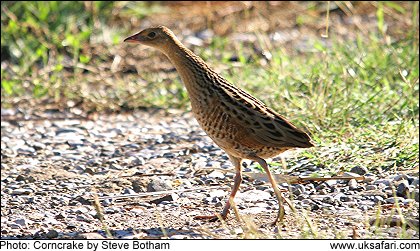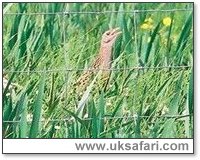
|

|
|
 Sent
to you Sent
to you
by e-mail
|
|
Simply
enter your details and hit the send button
more
info |
|


Click Here

Links
Advertise
Terms of Use
Contributors
About Us
Contact Us
|
 |
Go back
 | Bookmark
| Bookmark
 | Print Page
| Print Page  | E-Mail Us
| E-Mail Us 
 
 |
Latin name: Crex crex
Size: Approximately 30cms tall.
Distribution: The corncrake is a rare and declining summer visitor. It's remaining strongholds are in north-west Scotland and Ireland.
Months seen: April to October.
Food: Eats mainly insects, worms and seeds.
Habitat: Grassland and hayfields.
Special features: Corncrakes arrive from Africa in the spring (around mid-April) and leave again in August and September.
They are best located by their call which can be heard both day and night. In fact the Latin name for this bird comes from the grating call they make, which sounds like a comb being stroked (twice) across the edge of a cardboard box. If you get to see the bird you'll notice it has distinctive chestnut plumage on its flanks. It has long wings, and flies low with its legs dangling.
The main reason for its decline is believed to be the switch from growing grass for hay to growing it for silage. Grass grown for hay is rarely cut before August, while grass grown for silage is cut June and July. This is the time when corncrakes are nesting in fields, so nests, and eggs are destroyed by the silage mowing machines.
 Photo: Nicole Burgum
Photo: Nicole Burgum
|
On their nature reserves on Islay, Coll and other Hebridean islands, the RSPB have encouraged more corncrakes to nest by fencing off corners of fields to keep out grazing stock.
|
In addition, payments are being made to farmers for delayed hay and silage-cutting. The result has been a steady, increase in numbers in the last few years.

UK Safari Bird Section
|
 |

|